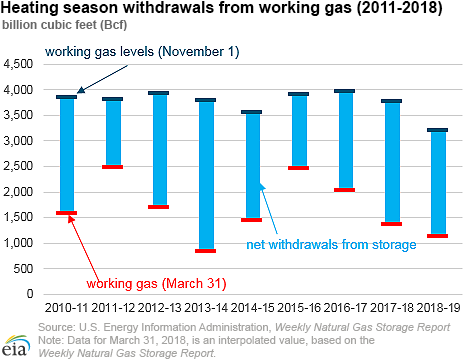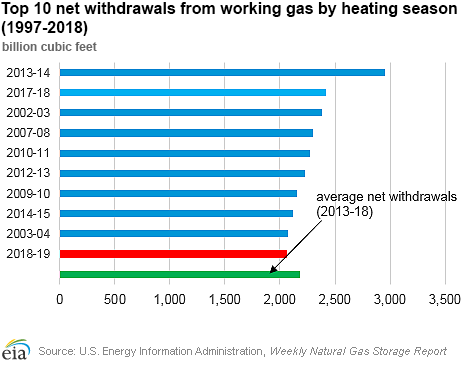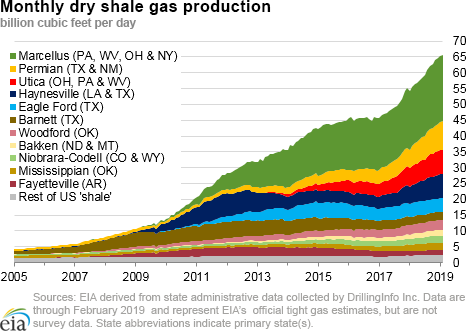In the News:
Natural gas stocks end heating season at the lowest level since 2014
Working natural gas in storage in the Lower 48 states as of March 31, the traditional end of the heating season (November 1–March 31), totaled 1,137 billion cubic feet (Bcf) according to EIA’s Weekly Natural Gas Storage Report released on April 11. As of March 31, working natural gas stocks were 491 Bcf (30%) lower than the five-year (2014–18) average for the end of the heating season. This heating season ended at the lowest level for working natural gas stocks since 2014, when working natural gas stocks totaled 837 Bcf. Last year, working natural gas stocks ended the winter at 1,360 Bcf.
Working natural gas stocks totaled 3,198 Bcf entering the winter heating season in November 2018—their lowest levels since 2005―and declined during the winter at a rate consistent with historical trends. Net withdrawals from storage during the 2018―19 heating season were 2,061 Bcf—5% below the five-year average for the season. The 2018–19 U.S. heating season was characterized by periods of significantly colder-than-normal temperatures—particularly in the Upper Midwest—that resulted in substantial natural gas storage withdrawals, as well as periods of lower-than-average withdrawals from storage.
The withdrawal season started early with colder-than-normal temperatures resulting in larger-than-normal withdrawals of 206 Bcf in November, almost two times as much as the five-year average. However, the pace of withdrawals slowed significantly during December, totaling 320 Bcf compared with the five-year average of 523 Bcf for the month. Although the largest weekly net withdrawals occurred during the week ending February 1, when 237 Bcf of natural gas was pulled from storage, withdrawals in the first three months of 2019 generally matched their five-year average.
This heating season had the 10th-highest net withdrawals on record, falling far short of the record 2,958 Bcf net withdrawals reported for the 2013–14 heating season. Net withdrawals from storage also fell below the 2,417 Bcf reported during the 2017–18 heating season. Both the 2013–14 and 2017–18 heating seasons were also characterized by periods of significantly colder-than-normal temperatures.
Overview:
(For the week ending Wednesday, April 10, 2019)
- Although natural gas spot prices fell at most locations this report week (Wednesday, April 3 to Wednesday, April 10), Henry Hub spot prices rose from $2.67 per million British thermal units (MMBtu) last Wednesday to $2.69/MMBtu yesterday.
- At the New York Mercantile Exchange (Nymex), the price of the May 2019 contract increased 2¢, from $2.677/MMBtu last Wednesday to $2.700/MMBtu yesterday. The price of the 12-month strip averaging May 2019 through April 2020 futures contracts climbed 3¢/MMBtu to $2.876/MMBtu.
- Net injections to working gas totaled 25 Bcf for the week ending April 5. Working natural gas stocks are 1,155 Bcf, which is 14% lower than the year-ago level and 30% lower than the five-year (2014–18) average for this week.
- According to Baker Hughes, for the week ending Tuesday, April 2, the natural gas rig count increased by 4 to 194. The number of oil-directed rigs rose by 15 to 831. The total rig count increased by 19, and it now stands at 1,025.
Prices/Supply/Demand:
Henry Hub and Chicago Citygate prices rise slightly while most other prices fall. This report week (Wednesday, April 3 to Wednesday, April 10), temperatures across the Lower 48 states were warmer than normal, despite a blizzard that set in across the Midwest on the last day of the report week. Henry Hub spot prices traded within a narrow range and rose 2¢ from $2.67/MMBtu last Wednesday to $2.69/MMBtu yesterday. At the Chicago Citygate, prices increased 4¢ from $2.58/MMBtu last Wednesday to $2.62/MMBtu yesterday.
California prices fall with decreased demand. Seasonal temperatures drove weekly demand down by 0.4 Bcf/d (5%) in the Pacific region, according to PointLogic Energy. Prices at PG&E Citygate in Northern California fell 40¢, down from $3.71/MMBtu last Wednesday to $3.31/MMBtu yesterday. Prices at SoCal Citygate decreased with warmer temperatures from $1.17 from $3.91/MMBtu last Wednesday to a weekly low of $2.74/MMBtu yesterday.
Northeast prices show little movement. At the Algonquin Citygate, which serves Boston-area consumers, prices went up 2¢ from $2.70/MMBtu last Wednesday to $2.72/MMBtu yesterday. At the Transcontinental Pipeline Zone 6 trading point for New York City, prices decreased 6¢ from $2.61/MMBtu last Wednesday to $2.55/MMBtu yesterday.
Tennessee Zone 4 Marcellus spot prices decreased 6¢ from $2.45/MMBtu last Wednesday to $2.39/MMBtu yesterday. Prices at Dominion South in southwest Pennsylvania fell 2¢ from $2.46/MMBtu last Wednesday to $2.44/MMBtu yesterday.
Waha prices recover throughout the week, returning to positive territory. Prices at the Waha Hub in West Texas, which is located near Permian Basin production activities, averaged a historical low of -$5.75/MMBtu last Wednesday, $8.42/MMBtu lower than Henry Hub prices. Yesterday, prices at the Waha Hub averaged $0.25/MMBtu, $2.44/MMBtu lower than Henry Hub prices. Prices rose as the force majeure in El Paso was lifted as the Natural Gas Pipeline’s Lordsburg compressor station came back online on March 30; however, planned maintenance through April 18 on the Transwestern pipeline is expected to reduce takeaway capacity and continue putting downward pressure on Waha Hub prices.
As reported last week, natural gas prices in the West Texas region have been depressed since 2017 because pipeline takeaway capacity has struggled to keep up with increasing production of associated-dissolved natural gas. Recent reductions in capacity have exacerbated this already constrained takeaway capacity, and spring temperatures are expected to reduce local demand of natural gas.
Supply falls. According to data from PointLogic Energy, the average total supply of natural gas fell by 1% compared with the previous report week. Dry natural gas production decreased by 1% compared with the previous report week. Average net imports from Canada decreased by 1% from last week.
Demand falls, driven by residential and commercial sectors. Total U.S. consumption of natural gas fell by 10% compared with the previous report week, according to data from PointLogic Energy. Decreases were largest in the residential and commercial sectors, where consumption declined by 25%. Natural gas consumed for power generation climbed by 4% week over week. Industrial sector consumption decreased by 5% week over week. Natural gas exports to Mexico decreased 1%.
U.S. liquefied natural gas (LNG) exports decrease week over week. Five LNG vessels (three from Sabine Pass and two from Cove Point) with a combined LNG-carrying capacity of 17.8 Bcf departed the United States from April 4 to April 10, according to shipping data compiled by Bloomberg. One vessel was loading at the Sabine Pass terminal on Wednesday.
On April 9, the Federal Energy Regulatory Commission (FERC) authorized Cameron LNG to introduce hazardous fluids to commission Train 1. Train 1 is expected to enter service in the second quarter of 2019.
Storage:
Net injections into storage totaled 25 Bcf for the week ending April 5, compared with the five-year (2014–18) average net injections of 5 Bcf and last year's net withdrawals of 20 Bcf during the same week. Working gas stocks totaled 1,155 Bcf, which is 485 Bcf lower than the five-year average and 183 Bcf lower than last year at this time.
According to The Desk survey of natural gas analysts, estimates of the weekly net change from working natural gas stocks ranged from net injections of 17 Bcf to 45 Bcf, with a median estimate of 34 Bcf.
More storage data and analysis can be found on the Natural Gas Storage Dashboard and the Weekly Natural Gas Storage Report.
See also:
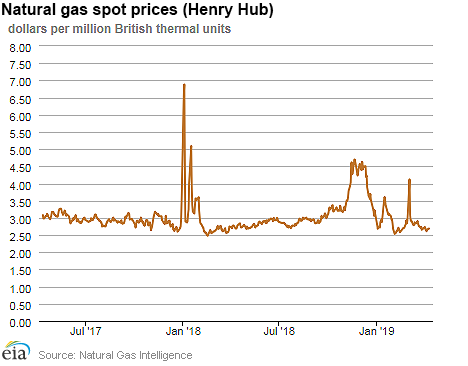
| Spot Prices ($/MMBtu) | Thu, 04-Apr |
Fri, 05-Apr |
Mon, 08-Apr |
Tue, 09-Apr |
Wed, 10-Apr |
|---|---|---|---|---|---|
| Henry Hub |
2.67 |
2.61 |
2.69 |
2.68 |
2.69 |
| New York |
2.58 |
2.30 |
2.59 |
2.56 |
2.55 |
| Chicago |
2.57 |
2.51 |
2.62 |
2.61 |
2.62 |
| Cal. Comp. Avg.* |
2.93 |
2.85 |
2.75 |
2.71 |
2.64 |
| Futures ($/MMBtu) | |||||
| May contract | 2.643 |
2.664 |
2.708 |
2.699 |
2.700 |
| June contract |
2.686 |
2.706 |
2.748 |
2.739 |
2.742 |
| *Avg. of NGI's reported prices for: Malin, PG&E Citygate, and Southern California Border Avg. | |||||
| Sources: Natural Gas Intelligence and CME Group as compiled by Bloomberg, L.P. | |||||
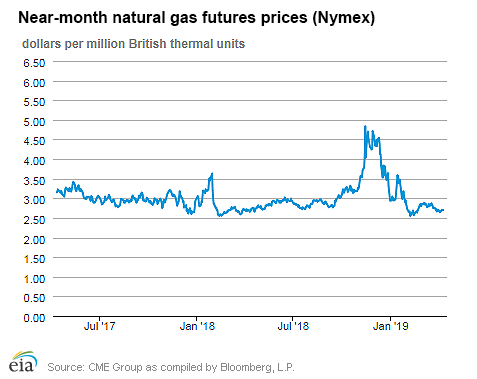
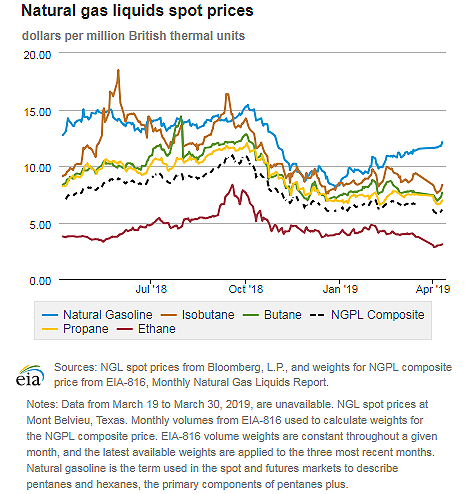
| U.S. natural gas supply - Gas Week: (4/4/19 - 4/10/19) | |||
|---|---|---|---|
Average daily values (Bcf/d): |
|||
this week |
last week |
last year |
|
| Marketed production | 99.5 |
100.4 |
90.8 |
| Dry production | 88.9 |
89.7 |
80.8 |
| Net Canada imports | 5.0 |
5.0 |
6.3 |
| LNG pipeline deliveries | 0.1 |
0.1 |
0.1 |
| Total supply | 93.9 |
94.8 |
87.2 |
|
Source: OPIS PointLogic Energy, an IHS Company | |||
| U.S. natural gas consumption - Gas Week: (4/4/19 - 4/10/19) | |||
|---|---|---|---|
Average daily values (Bcf/d): |
|||
this week |
last week |
last year |
|
| U.S. consumption | 62.7 |
69.3 |
76.8 |
| Power | 22.8 |
21.9 |
23.5 |
| Industrial | 20.4 |
21.4 |
21.9 |
| Residential/commercial | 19.5 |
26.1 |
31.4 |
| Mexico exports | 4.7 |
4.7 |
4.4 |
| Pipeline fuel use/losses | 6.0 |
6.2 |
6.0 |
| LNG pipeline receipts | 3.2 |
4.1 |
3.5 |
| Total demand | 76.5 |
84.3 |
90.7 |
|
Source: OPIS PointLogic Energy, an IHS Company | |||
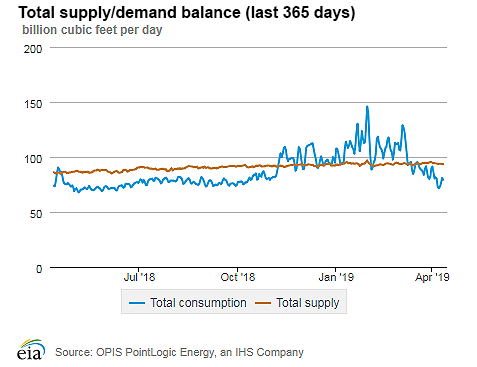
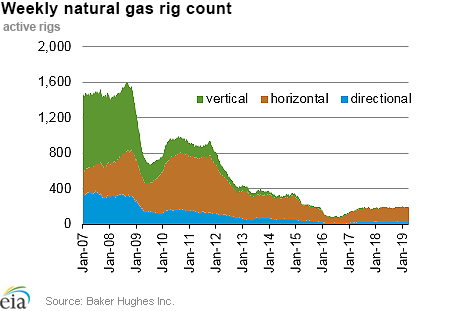
| Rigs | |||
|---|---|---|---|
Tue, April 02, 2019 |
Change from |
||
last week |
last year |
||
| Oil rigs | 831 |
1.8% |
2.8% |
| Natural gas rigs | 194 |
2.1% |
0.0% |
| Note: Excludes any miscellaneous rigs | |||
| Rig numbers by type | |||
|---|---|---|---|
Tue, April 02, 2019 |
Change from |
||
last week |
last year |
||
| Vertical | 54 |
5.9% |
-3.6% |
| Horizontal | 901 |
1.1% |
1.9% |
| Directional | 70 |
9.4% |
11.1% |
| Source: Baker Hughes Inc. | |||
| Working gas in underground storage | ||||
|---|---|---|---|---|
Stocks billion cubic feet (Bcf) |
||||
| Region | 2019-04-05 |
2019-03-29 |
change |
|
| East | 209 |
210 |
-1 |
|
| Midwest | 240 |
241 |
-1 |
|
| Mountain | 64 |
64 |
0 |
|
| Pacific | 119 C |
113 |
6 |
|
| South Central | 523 C |
502 |
21 |
|
| Total | 1,155 C |
1,130 |
25 |
|
|
Source: Form EIA-912, Weekly Underground Natural Gas Storage Report C = Reclassification Reclassifications from working gas to base gas resulted in decreased working gas stocks of 1 Bcf in the Pacific region and 2 Bcf in the South Central Salt region for the week ending April 5, 2019. | ||||
| Working gas in underground storage | |||||
|---|---|---|---|---|---|
Historical comparisons |
|||||
Year ago (4/5/18) |
5-year average (2014-2018) |
||||
| Region | Stocks (Bcf) |
% change |
Stocks (Bcf) |
% change |
|
| East | 219 |
-4.6 |
264 |
-20.8 |
|
| Midwest | 249 |
-3.6 |
332 |
-27.7 |
|
| Mountain | 84 |
-23.8 |
115 |
-44.3 |
|
| Pacific | 170 |
-30.0 |
207 |
-42.5 |
|
| South Central | 616 |
-15.1 |
722 |
-27.6 |
|
| Total | 1,338 |
-13.7 |
1,640 |
-29.6 |
|
| Source: Form EIA-912, Weekly Underground Natural Gas Storage Report | |||||
| Temperature – heating & cooling degree days (week ending Apr 04) | ||||||||
|---|---|---|---|---|---|---|---|---|
HDD deviation from: |
CDD deviation from: |
|||||||
| Region | HDD Current |
normal |
last year |
CDD Current |
normal |
last year |
||
| New England | 144 |
-22 |
-26 |
0 |
0 |
0 |
||
| Middle Atlantic | 137 |
-13 |
-22 |
0 |
0 |
0 |
||
| E N Central | 168 |
13 |
-12 |
0 |
0 |
0 |
||
| W N Central | 173 |
23 |
-40 |
0 |
-1 |
0 |
||
| South Atlantic | 85 |
5 |
0 |
12 |
-1 |
-7 |
||
| E S Central | 91 |
16 |
16 |
0 |
-5 |
0 |
||
| W S Central | 64 |
24 |
24 |
11 |
-4 |
-5 |
||
| Mountain | 131 |
-4 |
-20 |
3 |
-2 |
3 |
||
| Pacific | 65 |
-13 |
1 |
0 |
-2 |
0 |
||
| United States | 120 |
4 |
-9 |
4 |
0 |
-2 |
||
|
Note: HDD = heating degree day; CDD = cooling degree day Source: National Oceanic and Atmospheric Administration | ||||||||
Average temperature (°F)
7-day mean ending Apr 04, 2019
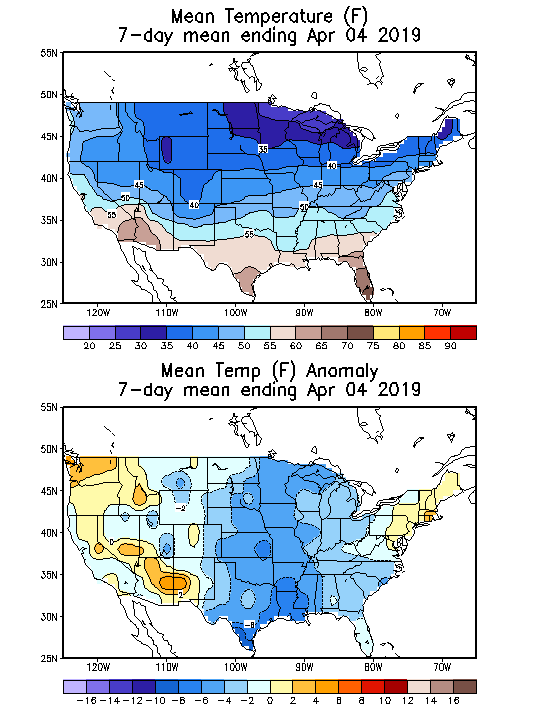
Source: National Oceanic and Atmospheric Administration
Deviation between average and normal (°F)
7-day mean ending Apr 04, 2019

Source: National Oceanic and Atmospheric Administration

